If you have a child in school right now, you may have received a number of letters sent home about precautionary measures to prevent the spread of the COVID-19 virus, a.k.a. the coronavirus. Keep your kids home if they’re sick. Sing “Happy Birthday” when washing your hands, and so on. What most of these letters don’t have is any kind of indication that the schools will be closing soon.
As of Wednesday, UNESCO reported that 290 million students are out of school as a result of virus containment efforts across the world. Officials in countries such as China, Hong Kong, Japan, and Italy have closed all schools for weeks. In the U.S., however, with only 225 confirmed coronavirus cases (of the 100,000 estimated worldwide) by Friday, only a handful of school districts have experienced closures.
Some parents and students in cities with confirmed cases are wondering why that is. On Change.org, high school and college students have created petitions asking for their institutions to close their doors and hold classes online. But that kind of blanket response is not called for, according to special pathogen specialist Dr. Syra Madad.
“The way New York City will respond to the coronavirus disease outbreak is going to be different than what the state of Washington is going to be doing,” said Madad, who is featured in Netflix’s new eerily timed docuseries Pandemic.
The virus is so new, and there are so many unknowns, Madad said, there’s no way of telling whether it’s more likely to spread in an environment like a school than in, say, the students’ parents’ offices or anywhere else in the community. This is why it’s so hard to find any expert or official saying definitively that schools should be closed.
“I don’t think any public health official is actually able to give you those types of answers, and if they do, they’re wrong, and they’re probably going to create more fear and chaos,” Madad explained.
As Live Science reported, the only information available to scientists about whether closing schools prevents the spread of a pandemic is in studies done on the flu. The fact that so far children make up a smaller percent of COVID-19 cases than they have in past flu pandemics makes many doubt whether the same practices are applicable.
The many reasons not to close schools
Any working parent can imagine the downsides of having schools closed for an indefinite period of time. Not all of us have jobs that can be done at home with rug rats on our backs. We can also see how this is affecting the families experiencing this in other countries.
“I think I would have quit my job if my son were younger, because I wouldn’t have been able to leave him alone at home,” Lee Seong-yeon, a health information officer of a hospital in Seoul, South Korea, told the New York Times of her 11-year-old son, who is home alone every day while she works.
Mothers in other cities told the paper they have had to stay at home, putting their work lives on pause. That means a potential loss of income for hourly wage earners, with countless ripple effects in the economy. There’s also the problem of how to serve meals to children who rely on school breakfasts and lunches during the week. Officials aren’t likely to want to cause such hardship in their communities until they have to.
How schools can stay safe
In the meantime, the Centers for Disease Control advises schools with no confirmed community cases to maintain good public health practices. That’s the stuff we’ve been seeing in those letters home.
“The message has always been clear and straightforward, the everyday respiratory practices that we want people to really pay attention to: washing their hands, covering their cough, staying home if they’re sick, seeing a health care provider if they if they need to,” Madad said.
The CDC has also advised schools to review and update their emergency plans with local health departments, and to establish procedures to make sure teachers and kids who are sick get sent home right away.
One change you might see taking place in your child’s school is that things are looking extra shiny and clean, because every “high touch” surface, from handrails and light switches to water fountains, should be getting cleaned and disinfected.
“Cleaning is just dusting off any impurities, but disinfecting is a chemical process that actually destroys germs,” Madad said. “We want to make sure people understand that cleaning high touch surfaces is obviously another good everyday measure that we want to employ.”
Remaining calm in the coronavirus media storm
Turning to online petitions or other sources that aren’t necessarily medical experts is not going to help things. Rather, Madad advises parents to look at the CDC, your health-care provider, and reports from local health officials for the latest, specific information on what’s affecting their community.
If the worst-case scenario happens and your school is closed, you might find yourself relieved we live in a digital age. Sites that offer online classes are gearing up for an influx of parents of bored kids. Outschool.com is even providing free training to teachers on how to conduct their own classes online. The CDC also included prepping for distance learning in its recommendations for schools.
Because I can’t live in a constant state of fear, I asked Madad about a theory I have about what life will be like when this virus eventually stops spreading. Could it be that we’ll wind up healthier overall, because we’ve been washing our hands so well and staying home every time we’ve got a sniffle?
“Every single outbreak is a teachable moment, and so we learn a lot of things from every one,” she said. That’s good to know, with or without school in session.
Source: Read Full Article

